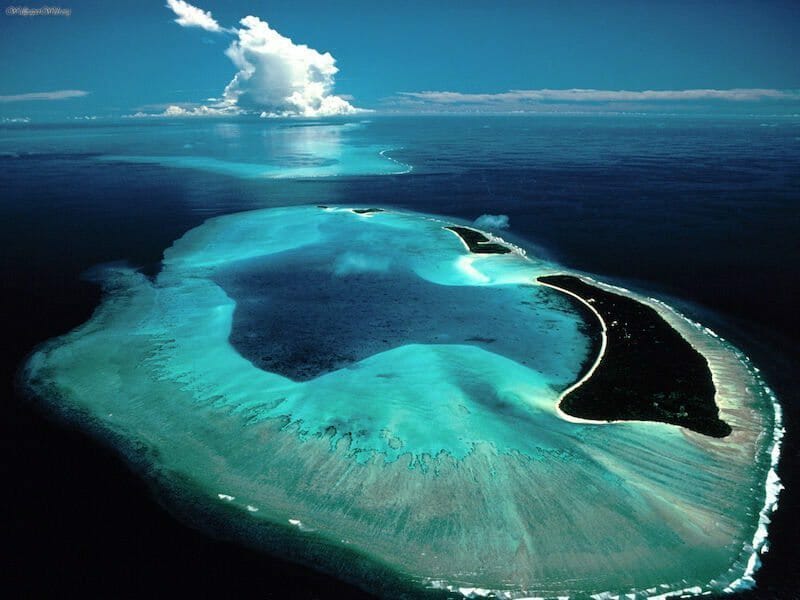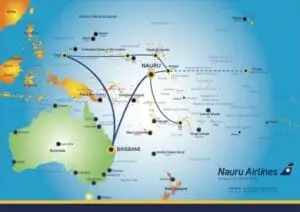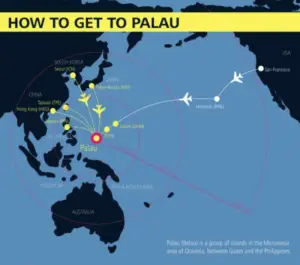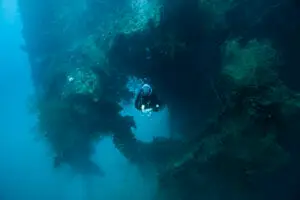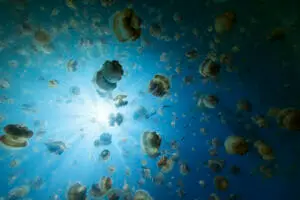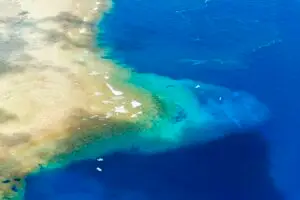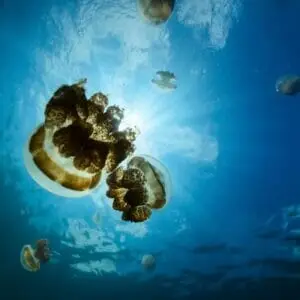In the far western Pacific, Palau is a place of emerald islands, turquoise seas, and coral reefs alive with color.
It’s a nation where ancient traditions are still part of daily life and where every island has a story to tell.
You might spend one day snorkeling with golden jellyfish, and the next exploring a centuries-old meeting house painted with myths.
Hike to jungle waterfalls, visit WWII battlefields, kayak through hidden lagoons, or relax on beaches so quiet you’ll have them all to yourself.
Palau is best known for its world-class diving, but this guide goes beyond the reefs.
Here, we’ve collected the best things to do in Palau, grouped by region, with practical tips for each stop: hours, access, costs, and what makes it worth your time.
Whether you’re planning a full island-hopping itinerary or a few cultural stops between dives, this guide will help you discover what makes Palau unforgettable both above and below the waterline.
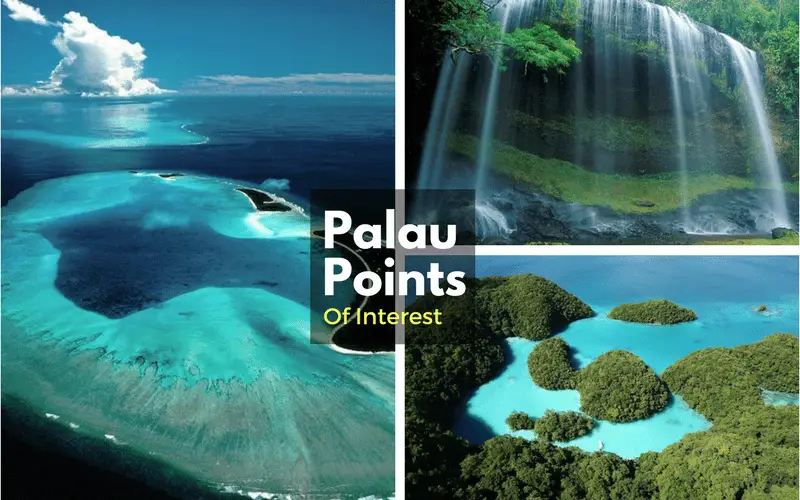
Top things to do in Palau
Koror & Malakal Island: Cultural Stops, Dining, and Nightlife
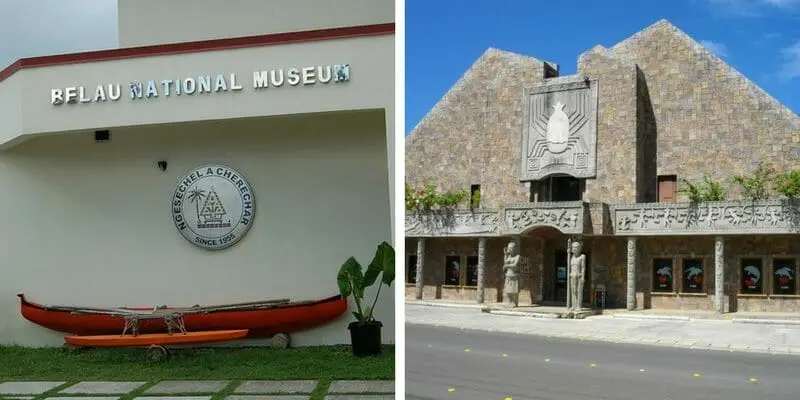
Etpison Museum
The Etpison Museum in Koror is one of Palau’s best places to learn about the islands’ culture and history. It opened in 1999, funded by the Etpison family, and sits on land donated by former President Ngiratkel Etpison.
Inside, you’ll find a mix of artifacts, photographs, and detailed models.
Highlights include a full-scale model of a bai (traditional meeting house), ancient shell and stone money, carved wooden storyboards, and rare seashells from Palau’s waters.
Exhibits also cover Palauan legends, early navigation, and colonial history.
The museum is small but packed with detail. It’s a good place to start your trip, giving you context for everything you’ll see later from village bais to WWII relics.
Staff are friendly and happy to answer questions, and the gift shop sells local handicrafts and books.
Practical info
Location: Main street, central Koror
Opening hours: Monday–Saturday, 9:00 am–5:00 pm
Entry fee: Around $10 USD
Suggested visit time: 45–60 minutes
Tip: Combine with a stop at the Belau National Museum, just a few minutes’ drive away
Belau National Museum
The Belau National Museum is the oldest museum in Palau, founded in 1955.
It’s located in central Koror and focuses on preserving and sharing the nation’s history, culture, and environment.
Inside, you’ll find exhibits on traditional Palauan life, including clothing, tools, and ceremonial items.
here’s also a section on Palau’s colonial periods under Spain, Germany, Japan, and the United States. Outside, the museum grounds feature a full-size bai, a sculpture garden, and a small natural history area with native plants.
Compared to the Etpison Museum, Belau National Museum has more outdoor space and offers a broader look at Palau’s political and environmental history.
Visiting both gives you a well-rounded picture of the islands’ heritage.
Practical info
Location: Main street, central Koror
Opening hours: Monday–Saturday, 9:00 am–5:00 pm
Entry fee: Around $10 USD
Suggested visit time: 45–60 minutes
Tip: Visit in the morning, then explore nearby shops and cafés before heading to your next stop
Drop-Off Bar & Grill
The Drop-Off Bar & Grill is one of Koror’s most popular waterfront hangouts. It’s located on Malakal Island, right by the marina, with open-air seating and uninterrupted sunset views over the water.
The atmosphere is casual and lively, making it a favorite for both locals and visiting divers.
The menu features fresh daily catch, grilled meats, and pub-style favorites, along with Palau’s own Red Rooster draft beer and tropical cocktails.
On some evenings, you’ll find live music or happy hour specials. It’s a great place to relax after a day on the water, swapping dive stories as the sun goes down.
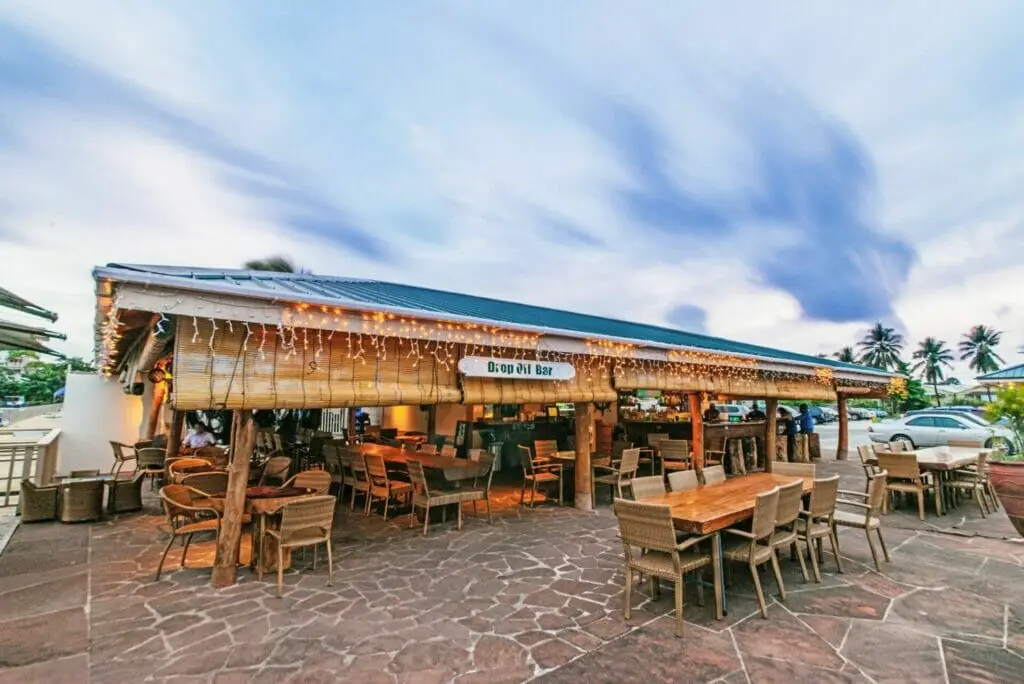
Practical info
Location: Malakal Island waterfront near dive shops and marinas
Opening hours: Daily from late morning until late evening
Price range: Moderate; mains from $10–$20 USD
Suggested visit time: 1–2 hours
Tip: Come for an early dinner to catch the sunset and avoid the busiest crowd later in the evening
Kramer’s Café/Bar & Restaurant
Kramer’s is a long-time favorite in Koror for fresh seafood and friendly service. It’s tucked into Pirate’s Cove on Malakal Island, with a deck that looks out over the marina, perfect for a breezy dinner.
The menu focuses on local fish, often caught the same day, alongside pasta, steak, and vegetarian options.
Signature dishes include blackened tuna, seafood pasta, and their well-known hibiscus mojito.
The atmosphere is relaxed and welcoming, drawing a mix of locals, expats, and visiting divers.
It’s a dinner-only spot, so it’s best to make a reservation during busy weeks.

Palau Dive Adventures team having fun at Kramer’s Restaurant.
Practical info
Location: Pirate’s Cove, Malakal Island
Opening hours: Dinner only, closed Sundays
Price range: Moderate; mains from $15–$25 USD
Suggested visit time: 1–2 hours
Tip: Sit outside if the weather’s clear — the marina views at sunset are some of the best in Koror
“We’ve been coming here for years — nothing beats fresh fish, a hibiscus mojito, and a sunset over the marina.”
Bottom Time Bar & Grill
The Bottom Time Bar & Grill sits right on the dock at Sam’s Tours Dive Center, making it one of the most convenient spots in Koror for a post-dive meal or drink.
The deck faces west, so you can watch the sun dip behind the Rock Islands while fishing boats and dive skiffs return for the evening.
The menu leans casual burgers, grilled fish, salads, and tropical cocktails with Palau’s own Red Rooster beer on tap.
On certain nights, there’s live music or BBQ specials, adding to the lively, social atmosphere.
Practical info
Location: Sam’s Tours Dive Center, Malakal Island
Opening hours: Daily from late morning until late evening
Price range: Moderate; mains from $10–$18 USD
Suggested visit time: 1–2 hours
Tip: Come just before sunset for the best views and to catch the buzz as dive boats return
Resorts & Relaxation
Koror isn’t just about culture and nightlife; it’s also home to Palau’s top resorts, where you can balance your adventures with a little luxury.
Both Palau Pacific Resort and Palau Royal Resort feature full-service spas, lagoon-front pools, and private beaches where you can recharge between dives.
At Palau Pacific Resort, the Elilai Spa by Mandara sits on a small hill overlooking the lagoon. Treatments draw on traditional Asian healing practices, blending exotic spices, fragrant flowers, and calming music to create a sense of deep relaxation.
It’s a tranquil escape designed to refresh body, mind, and spirit.
Opening hours: 1:00 PM – 9:00 PM (closed Tuesdays)
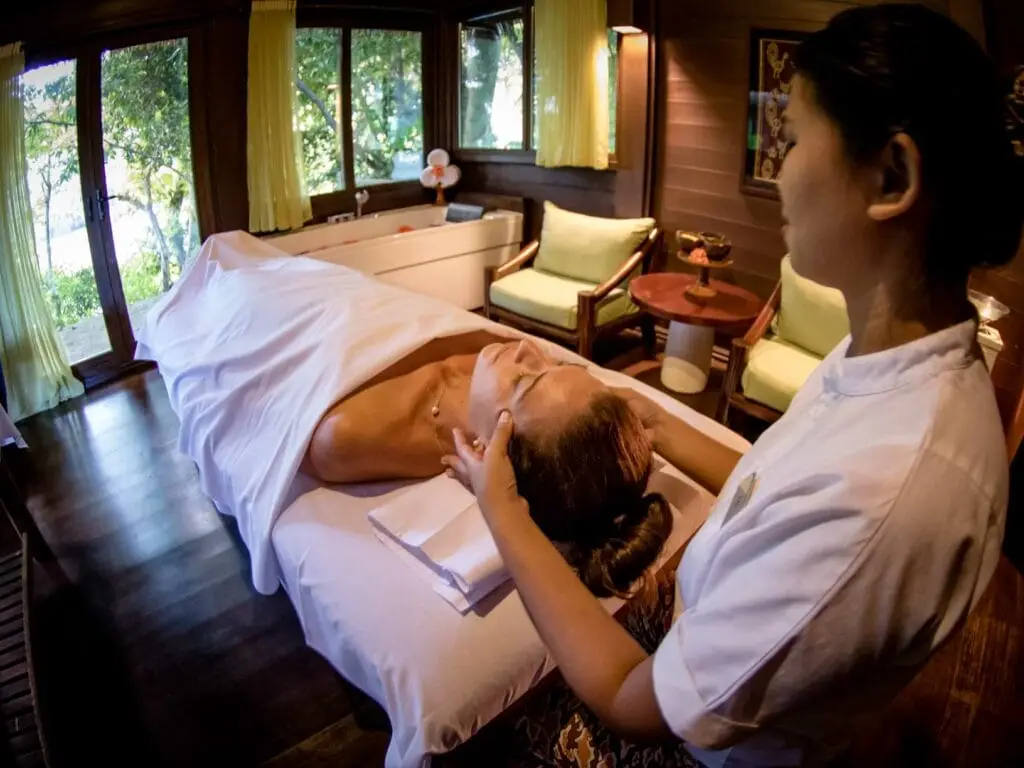
At Palau Royal Resort, the Mandara Spa offers the same world-class experience found at its branches throughout the Pacific and beyond. Nestled within Palau’s lush, tropical surroundings, it’s described as an “oasis” where guests can indulge in massages, facials, and body treatments.
Opening hours: 1:00 PM – 9:00 PM (closed Wednesdays)
Practical info
Palau Pacific Resort: Lagoon-front setting, infinity pool, private beach, Elilai Spa by Mandara (1 PM – 9 PM, closed Tuesdays)
Palau Royal Resort: Central Koror, gardens, private beach, Mandara Spa (1 PM – 9 PM, closed Wednesdays)
Tip: Even if you’re staying elsewhere, spa treatments and dining experiences can often be booked by outside guests
Learn more about Palau Pacific Resort and Palau Royal Resort in our full resort guide.
Wrap-Up: Culture, Dining & Island Life in Koror
Koror and Malakal Island offer the perfect mix of culture, dining, and relaxed island nightlife.
You can spend the morning learning Palauan history in the museums, then watch the sun set over the marina with fresh seafood and a cold beer.
Most visitors use this area as their base, with easy access to tours, shops, and the Rock Islands.
Once you’ve soaked up the atmosphere here, you’re ready to head out, whether it’s into the turquoise lagoons of the Rock Islands or north to the villages and landscapes of Babeldaob.
The Rock Islands A UNESCO World Heritage Lagoon
The Rock Islands are Palau’s crown jewel, a maze of limestone islets scattered across turquoise water, covered in lush greenery and surrounded by some of the clearest reefs in the Pacific.
This UNESCO World Heritage Site is home to hidden lagoons, natural arches, white sand beaches, and ancient cultural sites. Many of its highlights can only be reached by boat, making it an essential part of any trip to Palau.
Jellyfish Lake
Jellyfish Lake is one of Palau’s most unique natural wonders. Located on Eil Malk Island in the Rock Islands, it’s home to millions of golden jellyfish that have evolved without stingers, making it safe to snorkel among them.
The jellyfish follow the sun in a slow, daily migration across the lake. Floating in their midst feels surreal, like drifting through liquid gold.
The lake was closed from 2016 to 2018 to allow the jellyfish population to recover, but it has since reopened with strict protections.
“Even after years of guiding here, I still get goosebumps the moment I slip into the water — it’s like entering another world.”
Practical info
Location: Eil Malk Island, Rock Islands
Access: By boat tour from Koror (often combined with other Rock Islands stops)
Permit: Rock Islands & Jellyfish Lake permit required (~$100 USD, valid 10 days)
Suggested visit time: 1–2 hours (usually part of a half- or full-day tour)
Tip: Wear a rash guard instead of sunscreen to protect the lake’s delicate ecosystem
Rock Islands Southern Lagoon
The Rock Islands Southern Lagoon is the heart of Palau’s UNESCO World Heritage listing.
This vast area covers 445 small limestone islands, each with its own coves, beaches, and reefs. Many islands are uninhabited, making the scenery feel untouched and wild.
Trips through the Rock Islands often include snorkeling in coral gardens and kayaking through narrow channels.
Many tours also stop at Milky Way Lagoon, where you can cover yourself in mineral-rich white mud said to leave the skin feeling soft and refreshed.
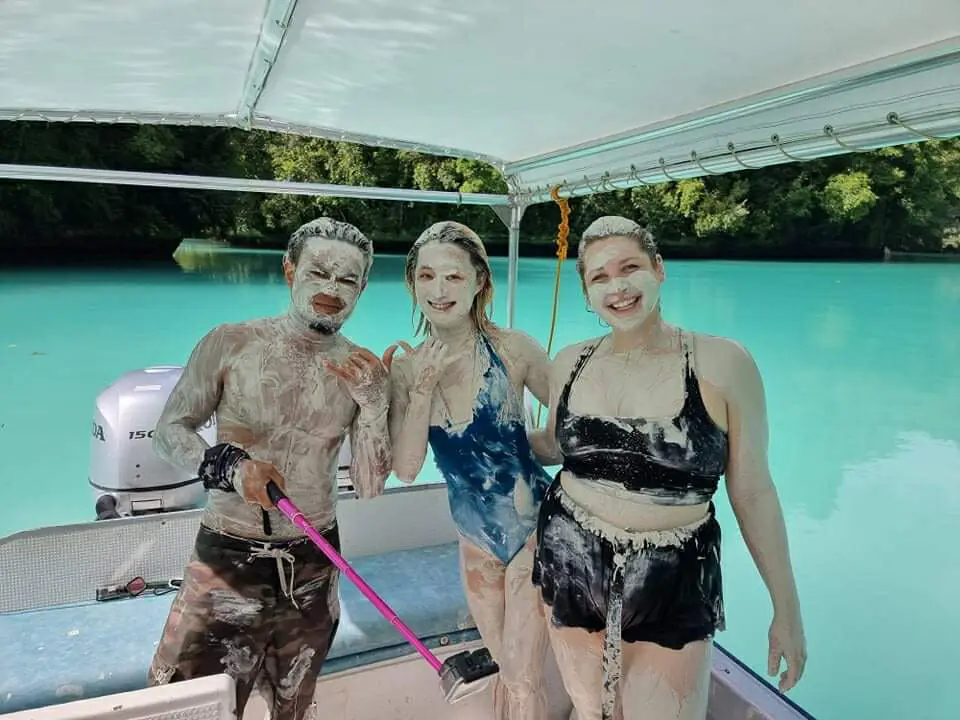
Another highlight is Natural Arch, a dramatic limestone bridge rising from the water one of the most photographed landmarks in the Rock Islands.
At low tide, Long Beach emerges as a narrow strip of sand that seems to float in the middle of the lagoon.

Practical info
Location: Southern Rock Islands, between Koror and Peleliu
Access: By boat tour from Koror
Permit: Rock Islands permit required (~$50 USD, valid 10 days; included if you purchase the Jellyfish Lake permit)
Suggested visit time: Full-day trip to see multiple highlights
Tip: Bring a dry bag you’ll be in and out of the water all day, and the boat ride can get wet
Wrap-Up: Scenic Adventures in the Rock Islands
The Rock Islands are the heart of Palau’s natural beauty a place where every turn in the lagoon reveals another hidden beach, archway, or reef.
Whether you come for a single day or spread your visit over several tours, the combination of turquoise water, lush limestone, and abundant marine life will stay with you long after you’ve left.
From here, it’s an easy jump to your next adventure exploring the cultural landmarks and wild landscapes of Babeldaob Island.
Babeldaob Island – Cultural Heartland & Natural Wonders
Babeldaob is Palau’s largest island and the cultural heart of the country. It’s far less developed than Koror, with quiet villages, dense forests, and a coastline that shifts from mangroves to golden beaches.
Here you’ll find some of Palau’s most important historical sites, from ancient stone monoliths to the oldest surviving bai (men’s meeting house), along with hiking trails, waterfalls, and panoramic viewpoints.
Many visitors explore Babeldaob on a day trip, driving a loop around the island to visit its key landmarks.
The journey offers a deeper glimpse into Palauan life, where modern government buildings sit alongside centuries-old traditions and untouched natural scenery.
Airai Bai
The Airai Bai is the oldest surviving bai in Palau, built around 1890 and still standing in the village of Airai on the southern tip of Babeldaob.
A bai is a traditional men’s meeting house a central place for decision-making, storytelling, and preserving cultural knowledge.
This bai is built entirely without nails, using hardwood beams and woven thatch. Its steep roof is painted with scenes from Palauan legends, including depictions of gods, spirits, and symbolic animals like the delerrok (money bird).
The entrance features a carved Dilukai, a female figure believed to protect the village and promote fertility.
“Every beam and painting here tells a story — you’re not just looking at a building, you’re looking at Palau’s history.”
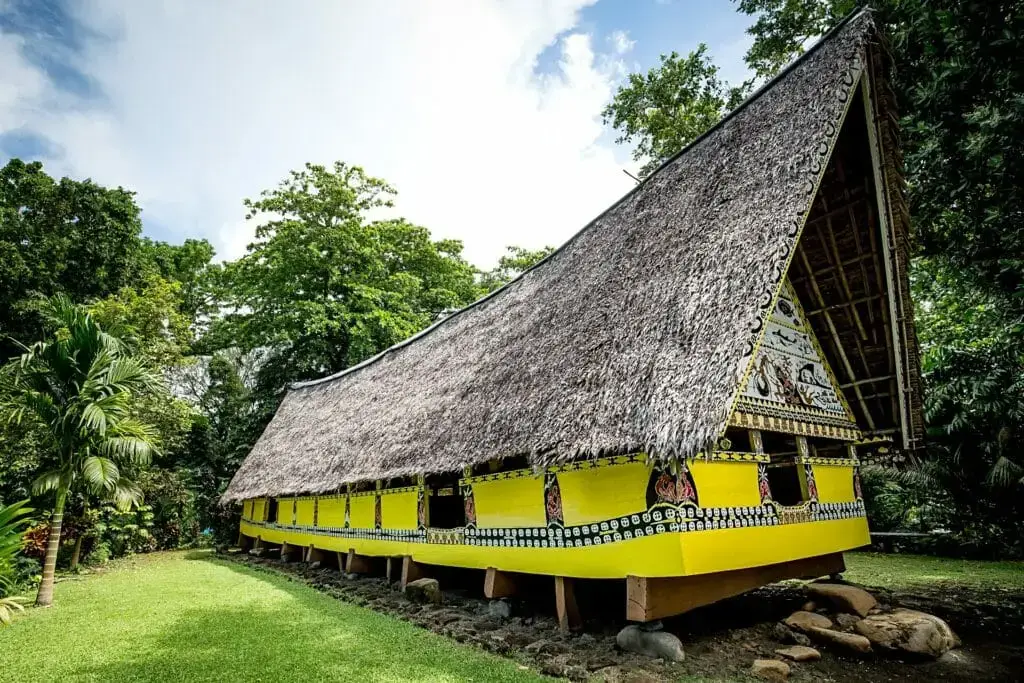
Practical info
Location: Airai village, southern Babeldaob
Access: 15–20 minutes by car from Koror
Opening hours: Vary; best to visit with a guide or call ahead
Entry fee: Small donation appreciated
Suggested visit time: 20–30 minutes
Tip: Combine with a visit to the nearby Airai State Office for more local history
Melekeok & Ngerulmud
Melekeok is a quiet coastal village on the east side of Babeldaob, known for its long stretch of beach and views over the Pacific.
Just inland lies Ngerulmud, Palau’s capital and the smallest national capital in the world by population.
The centerpiece of Ngerulmud is the National Capitol Building, a domed, neoclassical-style complex housing Palau’s executive, legislative, and judicial branches.
While you can’t tour the interior without special permission, the grounds are open, and the white columns and green dome make for striking photos against the surrounding hills.
A short drive away is Lake Ngardok Nature Reserve, home to Palau’s largest freshwater lake. The reserve’s trails offer birdwatching opportunities and views across rolling forest.
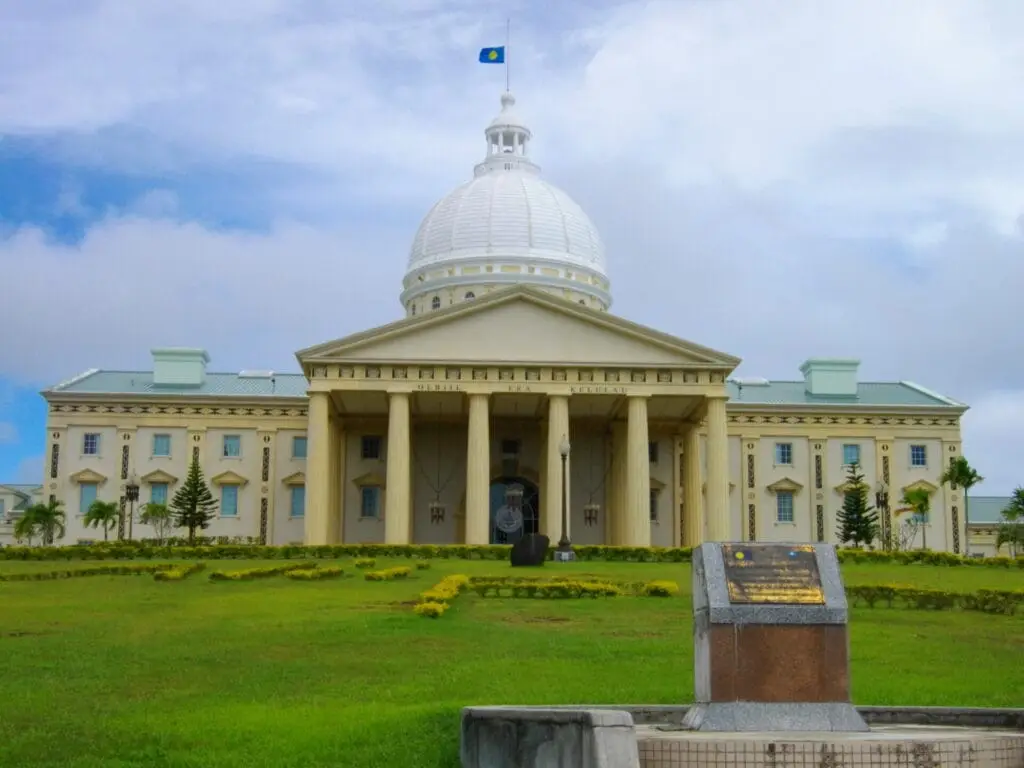
📸 By Abasaa
Practical info
Location: East-central Babeldaob
Access: About 45–50 minutes by car from Koror
Opening hours: Grounds open daily; government offices keep standard hours
Entry fee: None for outdoor viewing
Suggested visit time: 30–45 minutes
Tip: Combine with a stop at Lake Ngardok for a mix of history and nature in one trip
Ngardmau Waterfall
The Ngardmau Waterfall is Palau’s tallest, dropping about 30 meters (100 feet) into a natural swimming pool surrounded by jungle.
It’s located in Ngardmau State, on the northwest side of Babeldaob, and is a popular stop for both locals and visitors.
Getting there involves a 20–30 minute hike along a trail that follows an old Japanese-era railway from World War II.
Along the way, you’ll see remnants of the tracks, tropical flowers, and views of the surrounding hills.
The trail can be slippery after rain, but the reward is a cool swim at the base of the falls.
“After a hot day exploring Babeldaob, nothing beats the sound of the falls and a swim in that cold, clear water.”
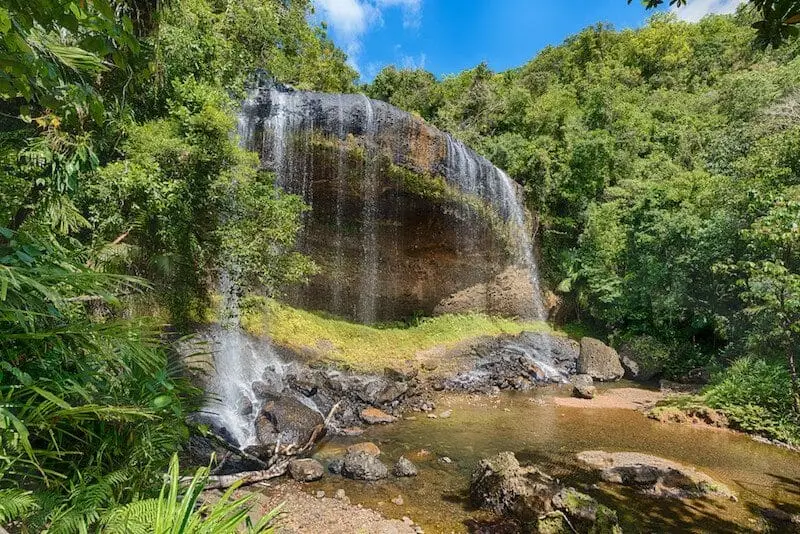
Practical info
Location: Ngardmau State, northwest Babeldaob
Access: About 1 hour by car from Koror
Opening hours: Daylight hours
Entry fee: Around $5–$10 USD
Suggested visit time: 1–2 hours including the hike
Tip: Wear sturdy shoes and bring water; the path can be slippery in places
Badrulchau Stone Monoliths
The Badrulchau Stone Monoliths are one of Palau’s oldest and most mysterious sites. Set on a grassy hilltop in Ngarchelong State, at the northern tip of Babeldaob, the site features more than 50 basalt pillars arranged in rows.
Some have simple carvings of faces, weathered by centuries of wind and rain.
Archaeologists estimate the stones date back to around 160 A.D. Many believe they were the foundation supports for an enormous bai (men’s meeting house), possibly the largest ever built in Palau.
According to legend, the structure was built by gods, each carrying the massive stones from distant islands.
The site’s elevated position offers panoramic views of the surrounding hills, coastline, and reef. It’s often quiet, with few visitors, making it an atmospheric stop on a Babeldaob loop.
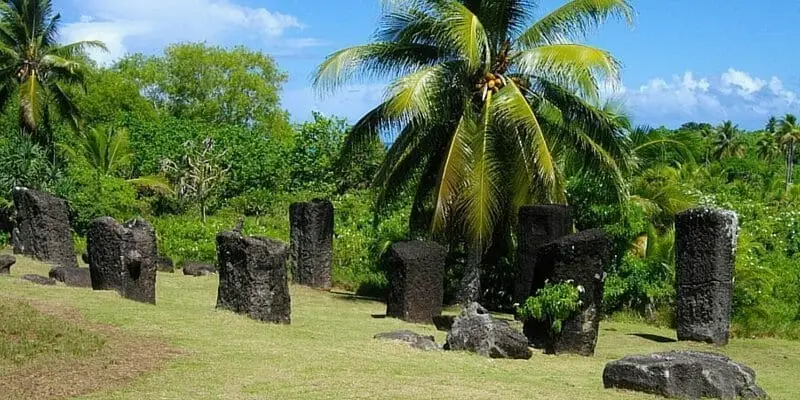
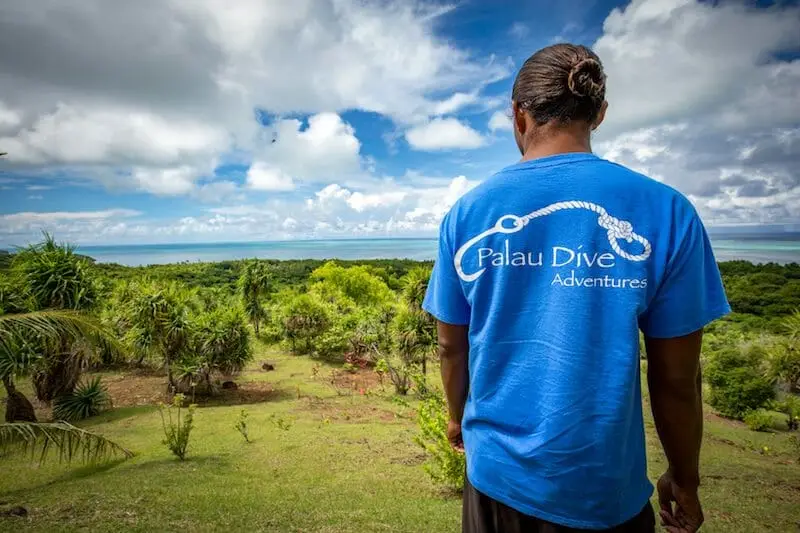
Practical info
Location: Ngarchelong State, northern Babeldaob
Access: About 1.5 hours by car from Koror via the ring road
Opening hours: Daylight hours
Entry fee: Small state fee (varies, usually a few USD)
Suggested visit time: 20–30 minutes
Tip: Go in the morning or late afternoon for softer light and better photos of both the monoliths and the reef below
Wrap-Up: History, Nature & Legends on Babeldaob
Babeldaob offers a side of Palau that many visitors never see: a mix of cultural landmarks, ancient history, and quiet natural beauty.
Driving the island loop takes you from centuries-old meeting houses to the country’s modern capital, past jungle waterfalls, and up to windswept hilltops with sweeping ocean views.
It’s a full-day journey that adds depth and variety to a Palau trip, balancing the thrill of the Rock Islands with the slower pace of village life and open landscapes.
Peleliu Island – WWII History & Remote Beauty
Peleliu Island, at the southern end of Palau, is best known for its role in one of the fiercest battles of World War II.
In September 1944, U.S. and Japanese forces fought here for more than two months, leaving behind airfields, bunkers, and rusting tanks that still stand as silent witnesses.
Today, Peleliu is a quiet, sparsely populated island with a mix of war memorials, unspoiled beaches, and excellent diving.
For guests on one of our 5-day dive packages (weather permitting), we include a two-tank dive in Peleliu, followed by the option to join a guided land tour in the afternoon.
It’s a perfect way to experience both the island’s spectacular underwater sites and its powerful wartime history in one trip.
Visiting Peleliu offers a striking contrast to Palau’s other islands. The pace is slower, the atmosphere more reflective, and the sense of history is palpable.
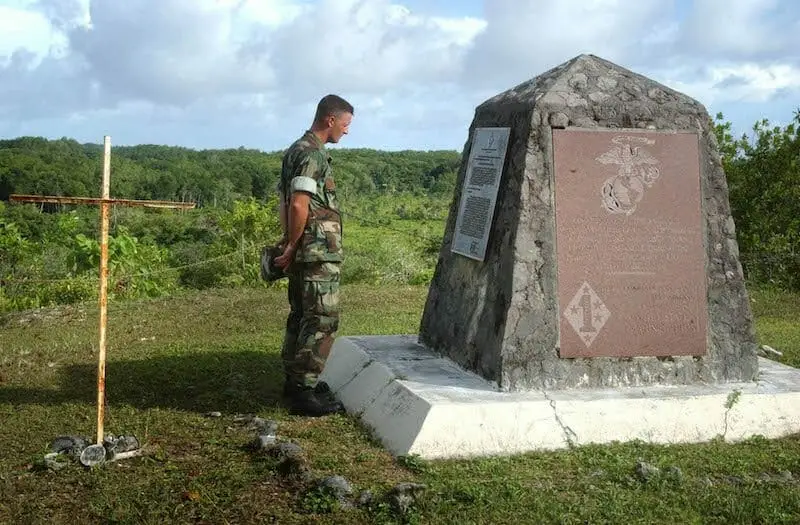
WWII Historical Sites
Peleliu’s battlefields are some of the most significant WWII sites in the Pacific.
The fighting here in 1944 was intense, lasting over two months and leaving deep scars on the island.
Today, many of these locations are preserved as memorials, museums, and open-air relics.
A guided land tour takes you to key sites, including:
Peleliu Airfield – Captured early in the battle, this long, open runway is where much of the fighting centered.
Japanese Defensive Positions – A network of bunkers, caves, and tunnels, many still intact.
Sherman Tanks & Artillery – Rusting war machines left where they were disabled.
Orange Beach & White Beach – The original U.S. landing zones, still marked by memorial plaques.
Peleliu WWII Memorial Museum – A small but powerful museum with photographs, artifacts, and personal accounts from both sides of the battle.
The experience is striking — you walk through peaceful jungle and quiet roads, yet every stop tells a story of courage, hardship, and loss.
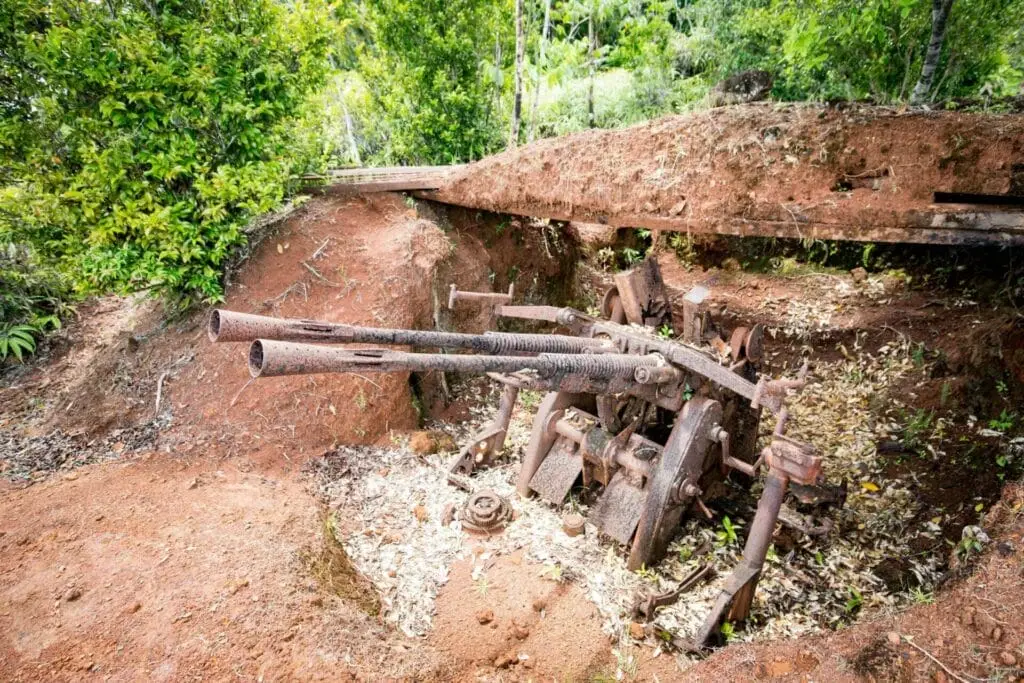
Peleliu offers a unique blend of adventure and history that you won’t find anywhere else in Palau.
The combination of diving its high-energy reefs in the morning and exploring its WWII landmarks in the afternoon gives you two completely different perspectives on the same island.
Whether you come for the underwater thrill, the historical insight, or both, Peleliu leaves a lasting impression one of resilience, beauty, and stories that still echo across its shores.
Angaur Island – Laid-Back Charm & Wildlife Encounters
South of Peleliu lies Angaur, Palau’s least populated state and one of its most peaceful islands. With no large resorts and only a handful of guesthouses, Angaur feels far removed from the busier hubs of Koror and the Rock Islands.
The pace here is slow, the beaches are quiet, and wildlife roams freely, including the island’s famous population of wild monkeys, descendants of animals brought over by the Japanese during their occupation.
Angaur is also known for its WWII history, with remnants of bunkers, airstrips, and artillery scattered around the island. Its surrounding waters offer excellent diving, including wrecks, reefs, and big pelagic encounters.
While few visitors make it this far south, those who do often say it feels like stepping into a different Palau, one where time moves at island speed.
Wildlife & Nature
Angaur’s most famous residents aren’t human; they’re the wild monkeys that roam the island. Brought over during the Japanese occupation, these macaques have adapted to the local environment and are often seen along the roadside or lounging in the trees.
While they’re used to people, it’s best to keep a respectful distance and avoid feeding them.
The island is also home to a variety of bird species, including fruit doves, kingfishers, and seabirds nesting along the cliffs.
Inland, you’ll find patches of lush jungle, small freshwater ponds, and quiet walking trails where the only sounds are wind and bird calls.
Along the coast, limestone cliffs and untouched beaches offer beautiful views and good chances for beachcombing.
Practical info
Location: Angaur Island, southern Palau
Access: By boat or small plane from Koror (less frequent than Peleliu)
Suggested visit time: Half-day to full-day if coming from Peleliu; overnight if staying in local guesthouses
Tip: Bring binoculars if you’re a birder. The island’s slow pace and small human population make it great for spotting wildlife undisturbed
WWII Historical Sites
Like Peleliu, Angaur saw fierce fighting during World War II. In October 1944, U.S. forces landed here as part of the Palau campaign, encountering heavy resistance from Japanese troops.
The battle lasted for weeks and left a lasting mark on the island.
Today, remnants from that time remain scattered across Angaur. You can find rusting artillery pieces, bunkers hidden in the jungle, and sections of the old Japanese airstrip.
Some of these sites are easy to reach along the main road, while others require short hikes into overgrown areas.
The atmosphere is quiet and reflective, especially given the island’s low population and limited tourist traffic.
Practical info
Location: Various points across Angaur Island
Access: Best explored with a local guide or by bicycle; some sites are off the main road
Suggested visit time: 1–2 hours to see several key locations
Tip: Wear sturdy shoes and be prepared for uneven paths; some relics are partially hidden by vegetation
Wrap-Up: Diving Into History on Peleliu & Angaur
Angaur is off the typical Palau travel circuit, but that’s what makes it special. Between its roaming monkeys, quiet beaches, and WWII relics tucked into the jungle, the island offers a slower, more personal side of Palau.
It’s best for travelers who want to get away from the crowds, spend time in nature, and see a part of the country few visitors experience.
Northern & Outlying Islands – Remote Villages & Untouched Reefs
Kayangel Atoll
Kayangel is Palau’s northernmost state, a ring of four small islands surrounding a turquoise lagoon about 40 km north of Koror.
With only around 140 residents, life here moves at a slow, communal pace centered on fishing and village life.
The atoll was devastated by Typhoon Haiyan in 2013 but has since been rebuilt with outside support, adding to its sense of resilience.
Visitors come for the atoll’s unspoiled beaches, crystal-clear water, and thriving reefs. Fishing is carefully managed, and the area is protected as part of Palau’s shark sanctuary, making it a paradise for snorkeling, kayaking, and eco-tours.
Infrastructure is minimal, a small school, community center, and a handful of guesthouses, so trips feel truly off the beaten path.
Ngarchelong
At the northern tip of Babeldaob lies Ngarchelong, one of Palau’s most culturally significant states.
It’s home to ancient stone monoliths, shrines, and old stone paths that hint at Palau’s deep past.
In the village of Ollei, you’ll find traditional stone fish traps that date back centuries and are still used today.
Ngarchelong is also the gateway to Kayangel, with many boat trips departing from here. Visitors can join community-led tours focused on fishing traditions, cultural history, and the natural environment.
Pairing Ngarchelong with a visit to the nearby Badrulchau Stone Monoliths makes for a rewarding half-day cultural trip at the top of Babeldaob.
Practical info
Location: Northern Babeldaob, about 1.5 hours by car from Koror
Access: By road; also serves as a departure point for Kayangel boat trips
Suggested visit time: Half-day, often combined with Badrulchau
Tip: Hire a local guide in Ollei to fully appreciate the fish traps and oral traditions tied to them
Wrap-Up: Culture and Conservation in Palau’s Far North
The northern and outlying islands may not see the same visitor numbers as Koror or the Rock Islands, but that’s exactly their charm.
From the resilient community of Kayangel Atoll to the cultural heritage of Ngarchelong, these areas showcase Palau’s quieter side, where ancient traditions and pristine nature still set the rhythm of daily life.
For travelers willing to go the extra distance, the reward is an authentic glimpse into Palau far beyond the typical itinerary.
TLDR; Experiencing Palau Beyond the Dive Sites
Palau is best known around the world for its spectacular diving, but as these points of interest show, there’s so much more waiting above the waterline.
From the cultural heart of Babeldaob and the historic battlefields of Peleliu, to the quiet rhythms of Angaur and Kayangel, each island offers its own story and perspective on Palauan life.
Exploring these places gives your trip more depth, balancing days underwater with moments of history, culture, and connection to local communities. Whether you’re here for a week of diving, a cultural adventure, or simply to relax, Palau rewards curiosity at every turn.
And when you dive with Palau Dive Adventures, we make sure you experience both sides of Palau, the world-class reefs and wrecks, and the unforgettable sights on land.
After all, the best memories are the ones that bring the whole picture together.
Highlights include the Airai Bai, Palau’s oldest traditional men’s meeting house; the Belau National Museum and Etpison Museum in Koror; and the Badrulchau Stone Monoliths in northern Babeldaob. Together, these sites showcase Palau’s legends, art, and history spanning from ancient times to modern independence.
Yes. The Rock Islands are accessible on day tours that include snorkeling, kayaking, and sightseeing. Popular stops include the Milky Way Lagoon, where visitors cover themselves in mineral-rich white mud, and the Natural Arch, a limestone bridge over turquoise water. Even non-divers can enjoy the dramatic scenery, lagoons, and wildlife.
The most significant are on Peleliu and Angaur, where fierce battles were fought in 1944. Visitors can explore the Peleliu Airfield, Japanese bunkers and caves, Sherman tanks, landing beaches, and the Peleliu WWII Memorial Museum. On Angaur, rusting artillery and airstrips remain in the jungle. These tours are often combined with diving for a full-day experience.
Yes. Kayangel Atoll, Palau’s northernmost state, is a pristine ring of four islets with fewer than 150 residents. It offers untouched beaches, eco-tours, and healthy reefs protected by conservation rules.
Ngarchelong, at the tip of Babeldaob, adds cultural depth with ancient fish traps, shrines, and stone paths. Both are less visited but provide an authentic glimpse into traditional Palau.
Absolutely. For example, our 5-day packages (weather permitting) include a two-tank dive in Peleliu, followed by a guided afternoon land tour of the island’s WWII sites. This lets divers balance underwater adventure with meaningful cultural and historical exploration.
In Koror, the Palau Pacific Resort and Palau Royal Resort are the top choices. Palau Pacific Resort features an infinity pool, private beach, and the Elilai Spa by Mandara.
Palau Royal Resort offers a lagoonfront setting, landscaped gardens, and the Mandara Spa. Both welcome non-guests for spa treatments and dining, making them great options even if you’re staying elsewhere.
Beyond diving, allow at least 2–3 days for land-based highlights. One day is ideal for Koror & Malakal (museums, dining, resorts), another for Babeldaob (Airai Bai, Melekeok, Ngardmau Falls, Badrulchau), and at least a day for either Peleliu or Kayangel/Ngarchelong. To experience both north and south, plan for a week or more.
Babeldaob is Palau’s largest island and the cultural heart of the country. It’s home to the national capital of Ngerulmud, the ancient Airai Bai, the scenic Ngardmau Waterfall, and the mysterious Badrulchau Stone Monoliths.
Driving the island loop provides a mix of cultural, historical, and natural landmarks often with very few other visitors around.
Yes. Though remote and lightly developed, Angaur welcomes visitors. It’s known for its wild monkeys, quiet beaches, and WWII relics.
Access is by boat or small plane from Koror, though schedules are limited. Guesthouses are available for overnight stays, making Angaur best for travelers who want to escape the crowds.
Definitely. While Palau is famous for diving, most of its cultural, historical, and nature attractions are land-based or accessible by snorkeling and boat tours. From museums in Koror to waterfalls on Babeldaob and island tours in Peleliu, there’s plenty to explore without scuba gear. Non-divers often enjoy the mix of history, wildlife, and relaxation Palau offers.


